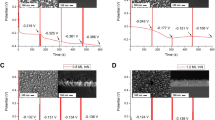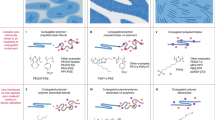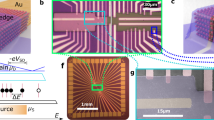Abstract
Ionic transport plays a central role in key technologies relevant to energy, and information processing and storage, as well as in the implementation of biological functions in living organisms. Here, we introduce a supramolecular strategy based on the non-destructive chemical patterning of a highly ordered self-assembled monolayer that allows the reproducible fabrication of ion-conducting surface patterns (ion-conducting channels) with top –COOH functional groups precisely definable over the full range of length scales from nanometre to centimetre. The transport of a single layer of selected metal ions and the electrochemical processes related to their motion may thus be confined to predefined surface paths. As a generic solid ionic conductor that can accommodate different mobile ions in the absence of any added electrolyte, these ion-conducting channels exhibit bias-induced competitive transport of different ionic species. This approach offers unprecedented opportunities for the realization of designed ion-conducting systems with nanoscale control, beyond the inherent limitations posed by available ionic materials.
This is a preview of subscription content, access via your institution
Access options
Subscribe to this journal
Receive 12 print issues and online access
$259.00 per year
only $21.58 per issue
Buy this article
- Purchase on Springer Link
- Instant access to full article PDF
Prices may be subject to local taxes which are calculated during checkout






Similar content being viewed by others
References
Owens, B. B. Solid state electrolytes: Overview of materials and applications during the last third of the twentieth century. J. Power Sources 90, 2–8 (2000).
Riess, I. Mixed ionic–electronic conductors—material properties and applications. Solid State Ion. 157, 1–17 (2003).
Tuller, H. L. Ionic conduction in nanocrystalline materials. Solid State Ion. 131, 143–157 (2000).
Guo, X. & Maier, J. Ionically conducting two-dimensional heterostructures. Adv. Mater. 21, 2619–2631 (2009).
Christie, A. M., Lilley, S. J., Staunton, E., Andreev, Y. G. & Bruce, P. G. Increasing the conductivity of crystalline polymer electrolytes. Nature 433, 50–53 (2005).
Livshits, E. et al. New insights into structural and electrochemical properties of anisotropic polymer electrolytes. Electrochim. Acta 50, 3805–3814 (2005).
Ratner, M. A. & Shriver, D. F. Ion transport in solvent-free polymers. Chem. Rev. 88, 109–124 (1988).
Schuster, M. F. H. & Meyer, W. H. Anhydrous proton-conducting polymers. Annu. Rev. Mater. Res. 33, 233–261 (2003).
Armand, M. & Tarascon, J-M. Building better batteries. Nature 451, 652–657 (2008).
Tuller, H. L., Litzelman, S. J. & Jung, W. Micro-ionics: Next generation power sources. Phys. Chem. Chem. Phys. 11, 3023–3034 (2009).
Terabe, K., Hasegawa, T., Nakayama, T. & Aono, M. Quantized conductance atomic switch. Nature 433, 47–50 (2005).
Waser, R., Dittmann, R., Staikov, G. & Szot, K. Redox-based resistive switching memories—nanoionic mechanisms, challenges. Adv. Mater. 21, 2632–2663 (2009).
Nakanishi, H. et al. Dynamic internal gradients control and direct electric currents within nanostructured materials. Nature Nanotech. 6, 740–746 (2011).
Valov, I., Waser, R., Jameson, J. R. & Kozicki, M. N. Electrochemical metallization memories—fundamentals, applications, prospects. Nanotechnology 22, 254003 (2011).
Feinerman, O., Rotem, A. & Moses, E. Reliable neuronal logic devices from patterned hippocampal cultures. Nature Phys. 4, 967–973 (2008).
Maoz, R., Frydman, E., Cohen, S. R. & Sagiv, J. Constructive nanolithography: Inert monolayers as patternable templates for in-situ nanofabrication of metal–semiconductor–organic surface structures—a generic approach. Adv. Mater. 12, 725–731 (2000).
Liu, S., Maoz, R. & Sagiv, J. Planned nanostructures of colloidal gold via self-assembly on hierarchically assembled organic bilayer template patterns with in-situ generated terminal amino functionality. Nano Lett. 4, 845–851 (2004).
Zeira, A., Chowdhury, D., Maoz, R. & Sagiv, J. Contact electrochemical replication of hydrophilic–hydrophobic monolayer patterns. ACS Nano 2, 2554–2568 (2008).
Zeira, A., Berson, J., Feldman, I., Maoz, R. & Sagiv, J. A bipolar electrochemical approach to constructive lithography: Metal/monolayer patterns via consecutive site-defined oxidation and reduction. Langmuir 27, 8562–8575 (2011).
Berson, J., Zeira, A., Maoz, R. & Sagiv, J. Parallel- and serial-contact electrochemical metallization of monolayer nanopatterns: A versatile synthetic tool en route to bottom-up assembly of electric nanocircuits. Beilstein J. Nanotech. 3, 134–143 (2012).
Garcia, R., Knoll, A. W. & Riedo, E. Advanced scanning probe lithography. Nature Nanotech. 9, 577–587 (2014).
Maoz, R., Sagiv, J., Degenhardt, D., Möhwald, H. & Quint, P. Hydrogen-bonded multilayers of self-assembling silanes: Structure elucidation by combined Fourier transform infra-red spectroscopy and X-ray scattering techniques. Supramol. Sci. 2, 9–24 (1995).
Maoz, R., Yam, R., Berkovic, G. & Sagiv, J. in Thin Films Vol. 20 (ed. Ulman, A.) 41–68 (Academic Press, 1995).
Wen, K. et al. Postassembly chemical modification of a highly ordered organosilane multilayer: New insights into the structure, bonding, and dynamics of self-assembling silane monolayers. ACS Nano 2, 579–599 (2008).
Gericke, A. & Hühnerfuss, H. The effect of cations on the order of saturated fatty acid monolayers at the air-water interface as determined by infrared reflection-absorption spectrometry. Thin Solid Films 245, 74–82 (1994).
Tao, Y-T. Structural comparison of self-assembled monolayers of n-alkanoic acids on the surfaces of silver, copper, and aluminum. J. Am. Chem. Soc. 115, 4350–4358 (1993).
Smith, E. L., Alves, C. A., Anderegg, J. W., Porter, M. D. & Siperko, L. M. Deposition of metal overlayers at end-group-functionalized thiolate monolayers adsorbed on Au. 1. Surface and interfacial chemical characterization of deposited Cu overlayers at carboxylic acid-terminated structures. Langmuir 8, 2707–2714 (1992).
Gershevitz, O., Osnis, A. & Sukenik, C. N. Interfacial chemistry on carboxylate-functionalized monolayer assemblies. Isr. J. Chem. 45, 321–336 (2005).
Maoz, R., Matlis, S., DiMasi, E., Ocko, B. M. & Sagiv, J. Self-replicating amphiphilic monolayers. Nature 384, 150–153 (1996).
Maoz, R. & Sagiv, J. Targeted self-replication of silane multilayers. Adv. Mater. 10, 580–584 (1998).
Conway, B. E. & Bockris, J. O’M. Electrolytic hydrogen evolution kinetics and its relation to the electronic and adsorptive properties of the metal. J. Chem. Phys. 26, 532–541 (1957).
Kleperis, J. et al. Electrochemical behavior of metal hydrides. J. Solid State Electrochem. 5, 229–249 (2001).
Boulas, C., Davidovits, J. V., Rondelez, F. & Vuillaume, D. Suppression of charge carrier tunneling through organic self-assembled monolayers. Phys. Rev. Lett. 76, 4797–4800 (1996).
Chowdhury, D., Maoz, R. & Sagiv, J. Wetting driven self-assembly as a new approach to template-guided fabrication of metal nanopatterns. Nano Lett. 7, 1770–1778 (2007).
Agmon, N. The Grotthuss mechanism. Chem. Phys. Lett. 244, 456–462 (1995).
Forouzan, F. & Bard, A. J. Evidence for faradaic processes in scanning probe microscopy on mica in humid air. J. Phys. Chem. B 101, 10876–10879 (1997).
Takahashi, T., Yamamoto, O., Yamada, S. & Hayashi, S. Solid-state ionics: High copper ion conductivity of the system CuCl–CuI–RbCl. J. Electrochem. Soc. 126, 1654–1658 (1979).
Staunton, E., Andreev, Y. G. & Bruce, P. G. Factors influencing the conductivity of crystalline polymer electrolytes. Faraday Discuss. 134, 143–156 (2007).
Zhang, C. et al. Alkali metal crystalline polymer electrolytes. Nature Mater. 8, 580–584 (2009).
Kamaya, N. et al. A lithium superionic conductor. Nature Mater. 10, 682–686 (2011).
Whittingham, M. S. & Huggins, R. A. Transport properties of silver beta alumina. J. Electrochem. Soc. 118, 1–6 (1971).
Rice, M. J. & Roth, W. L. Ionic transport in super ionic conductors: A theoretical model. J. Solid State Chem. 4, 294–310 (1972).
Maoz, R., Frydman, E., Cohen, S. R. & Sagiv, J. Constructive nanolithography: Site-defined silver self-assembly on nanoelectrochemically patterned monolayer templates. Adv. Mater. 12, 424–429 (2000).
Acknowledgements
This research was supported by the Israel Science Foundation (grant No. 931/12) and G. M. J. Schmidt Minerva Center of Supramolecular Architectures. We are grateful to I. Lubomirsky (Weizmann Inst.), E. Gileadi (Tel Aviv Univ.), I. Riess (Technion) and A. Yochelis (Ben-Gurion University of the Negev) for illuminating discussions, H. Cohen for the XPS measurements, G. Gotesman for assistance in the SEM imaging, B. Pasmantirer for assistance in the design of the probe station and equipment for the preparation of electrodes and macro-channels, and O. Westmark for assistance with the graphical presentation.
Author information
Authors and Affiliations
Contributions
J.B.: AFM monolayer nanopatterning (CNL) and imaging, AFM electrical imaging, SEM imaging, analysis and summary of AFM and SEM data. D.B.: AFM monolayer nanopatterning (CNL) and imaging, design of the probe station and of electrochemical measurement set-ups, electrical measurements, analysis and summary of AFM, electrochemical and electrical data. A.Z.: AFM monolayer nanopatterning (CNL), monolayer macropatterning (CEP). A.Y.: development of non-destructive electron-beam deposition procedures for the fabrication of the electrodes and macro-channels. R.M.: supervision of the research, initiation and design of experimental set-ups, monolayer assembly and characterization, monolayer macropatterning (CEP), FTIR measurements, electrical measurements, analysis and summary of FTIR and electrical data. J.S.: initiation and supervision of the research, overall analysis and summary of the experimental results, writing of the manuscript. All authors discussed the results and commented on their interpretation.
Corresponding authors
Ethics declarations
Competing interests
The authors declare no competing financial interests.
Supplementary information
Supplementary Information
Supplementary Information (PDF 4583 kb)
Rights and permissions
About this article
Cite this article
Berson, J., Burshtain, D., Zeira, A. et al. Single-layer ionic conduction on carboxyl-terminated silane monolayers patterned by constructive lithography. Nature Mater 14, 613–621 (2015). https://doi.org/10.1038/nmat4254
Received:
Accepted:
Published:
Issue Date:
DOI: https://doi.org/10.1038/nmat4254
This article is cited by
-
An artificial synapse based on molecular junctions
Nature Communications (2023)
-
Stable solar water splitting with wettable organic-layer-protected silicon photocathodes
Nature Communications (2022)
-
Nanomanufacturing of silicon surface with a single atomic layer precision via mechanochemical reactions
Nature Communications (2018)
-
DNA condensation in one dimension
Nature Nanotechnology (2016)



